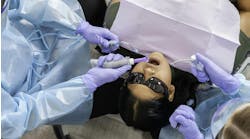When it comes to success for private practitioners, money management often takes a backseat as a focal point. I’m an ardent believer that your core values must remain front and center, however, your ability to properly budget cannot be ignored. Yes, you need to make company culture the top priority, but your financial wherewithal should be embedded in the fabric of who you are, right alongside your commitment to service and leadership.
To gain a better understanding of the most common financial pitfalls dentists encounter, I met with renowned CPA John P. Cataldo, founder of Cataldo Financial and Consulting Group. As a representative of independent dentists from coast to coast the past 40 years, Cataldo has built a reputation for maximizing efficiency and implementing systems that allow small private practices to not only hold their own but thrive among the large DSOs.
He spoke about the Tale of Two Practices, his video series and a real-world analogy of how two dentists, each bringing in $1 million in yearly business, can end up with starkly contrasting profits. In short, the first dentist took home more than $500,000 while the other barely eked out half that amount.
Regardless of which camp you’re in, the story behind the allegory is that all of us can make smarter decisions that ultimately lead to greater profitability. Perhaps most helpful of all, Cataldo asserted that if you were forced to write out a weekly check that totaled all the inefficiencies your practice cost you that week, you’d quickly eliminate those pesky snags. But since you don’t write that check, and since those costs remain hidden from plain view, most inefficiencies are ignored for far too long.
Your accounts receivable may not be ideal
Perhaps the biggest problem plaguing dentists who have a steady stream of business, yet struggle to make ends meet, revolves around their accounts receivable (AR). Ideally, your ledger of receivables should be about a page long and resolved within about 45-day rolling increments. If your list is longer, and your repayment calendar is closer to 90 days, that may be a sign of serious trouble.
If this is a struggle for you, it’s hard to know where to begin. First, keep in mind that there’s nothing wrong with asking for payment when a service is rendered. Patients understand that when they purchase something at a department store, they can’t leave and explain that they’ll pay the bill when they get around to it. Even if they use a credit card, the terms and conditions are outlined from the beginning. To be fair, receiving payment from insurers requires a different set of tactics, but the premise is basically the same. You not only need a method of payment, but it must be based on fair market value, and you need to ensure that it's collected in a timely manner.
For some dentists, collecting payments might be less of an insurance problem and more of a staff issue. If you haven’t made sure that everyone on your team understands their duties, make those responsibilities perfectly clear. An organizational chart goes a long way toward clearing up any confusion, specifically regarding payment collection.
If your staff has questions about what they should be doing, make a list and place it in everyone’s hands. Require the AR person to draft a weekly log of all payments received, balances outstanding, and communications to capture said revenue. You usually won’t have to read the log each week. Even if you read it once every three weeks, the fact that your staff is focused on physically documenting accounts and updating them regularly in the process will ensure that most outstanding balances are collected on schedule.
Think before increasing your patient base
For dentists actively seeking to increase their patient base, keep in mind that if the issues here aren’t addressed, boosting your workload will be a hindrance rather than a blessing. The last thing you want to do is use up more of your time and resources without the requisite systems in place to collect revenue.
But let’s assume you’ve gotten that aspect of your office in working order. Now it’s time to increase your marketing efforts. Tread with caution. The most effective marketing shouldn’t cost you anything. Your best advertisement is in the form of patient satisfaction.
This is particularly true in upper class markets where the cost of your services is not much of an issue. These people care most about the quality of your work and the care with which you deliver it, and they’ll reward you with referrals. Your reputation is worth infinitely more than the $20,000 you might shell out to chase new patients on social media.
In fact, before you sign any money over to Facebook, consider advertising in your local paper, which is significantly less expensive and more likely to reach the demographic you’re seeking. Or you might want to eschew traditional advertising altogether and increase your community involvement, perhaps by sponsoring a local 5K race or a charity event.
Regardless of the investment you make in your business, you need to understand the overall impact it will have on your bottom line. Whether it’s investing in new equipment, growing your staff, or increasing your marketing budget, you should have a grasp of the added value before you write the check. Unfortunately, if your big strategy to justify your latest equipment upgrade is a huge upfront tax deduction, you’re doing nothing to alleviate the future interest payments on that expenditure in the coming years. Don’t let such investments turn into burdensome liabilities.
Empowering yourself with knowledge makes all the difference. An accountant can give you access to critical insights long before you shell out precious capital. No money should ever be spent on a whim. You don’t have to foresee every monetary entanglement along the path to greater profitability. You simply need to befriend an accountant who can spot them for you.
Editor's note: This article appeared in the March 2024 print edition of Dental Economics magazine. Dentists in North America are eligible for a complimentary print subscription. Sign up here.
Mark B. Murphy, CEO of Northeast Private Client Group, is an accomplished author, speaker, and motivator who's revolutionizing the financial planning and wealth management industry. He helps entrepreneurs achieve multigenerational wealth through personalized strategies, leveraging his strategic planning and financial engineering expertise. Forbes has ranked him as the number one financial security professional in New Jersey and number 15 nationwide. Additionally, his book, The Ultimate Investment, is a number one bestseller and new release on Amazon.








